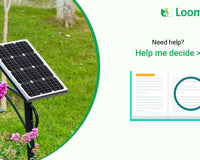The first thing that is done while installing solar system is the site survey. In the site survey, first checked where the solar panel will be installed, its direction, type of structure, how much area it will need, direction of wiring, how connect the components to each other, earthing etc. From which a customer can know that this solar system will be installed here in my house. If you are confused about the installation process, you can book the engineer site survey that is provided by loom solar Pvt. Ltd.
Which appliances run on the grid solar system?
The on-grid solar system works in sync with the grid, unlike inverters, there is no limitation in the grid-tied system, you can run everything off your home on the grid-tied solar system. For example, a 1 kW on-grid system can run 5 kW power.
What are the components of an on grid solar system?
Solar energy systems connected to the electricity grid range from small home systems on roofs to large solar power plants. They hardly use integrated battery solutions, unlike stand-alone power systems. Here are some benefits of on-grid solar power system:1 - No need for the battery
2 - With the technology development, the inverter will be more stable and reliable.
3. The grid-connected solar system is the most cost-effective type of solar system for homeowners.
4. If you install a grid-tied solar system, it can produce power whenever you use it. If you only consume a small amount of energy, the rest will be converted into money for you by your state government.
5. It is perfectly integrated with your buildings, which can not only generate electricity, but also be part of your building.
Solar Panel Installation Process
Step 1: Type of Roof
Step 2: Shadow Free Area
Step 3: Mounting Structure
Step 4: Placement (As per space no. of rows will decide)
Step 5: Structure Assembling
Step 6: Panels Mounting











